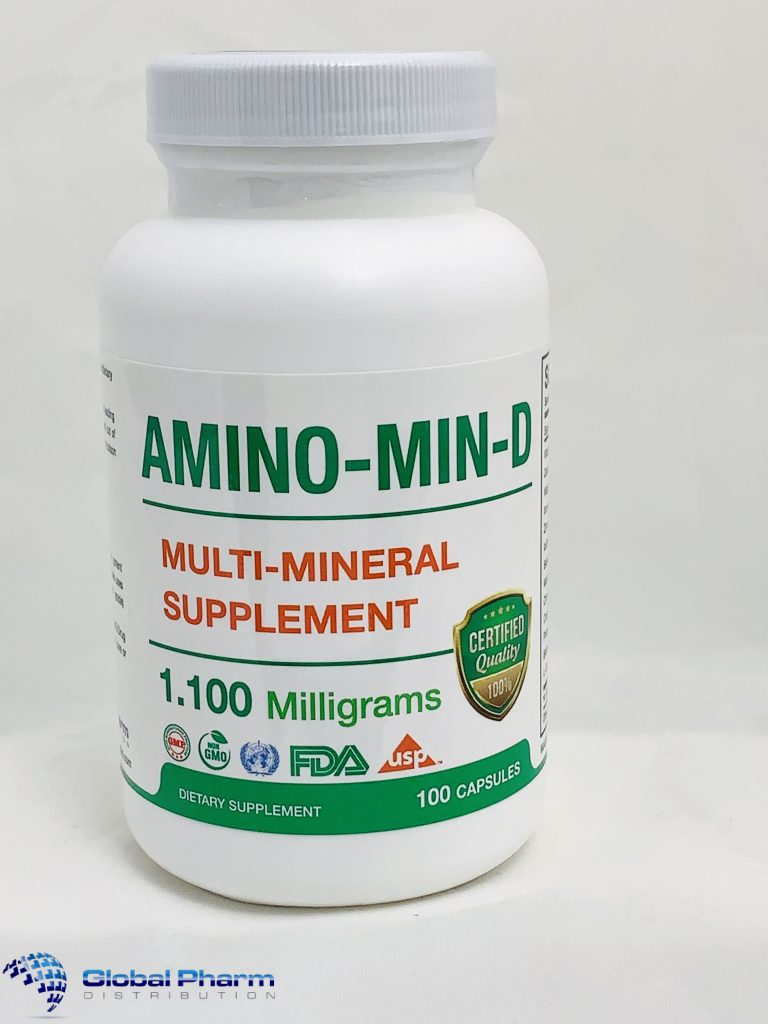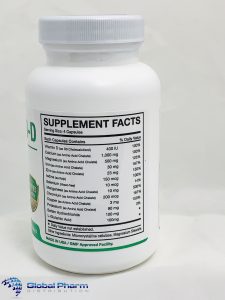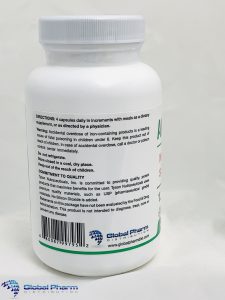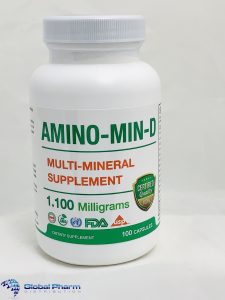Description
AMINO-MIN-D is a broad spectrum multi-mineral and vitamin D preparation encapsulated and chelated with amino acids for better bio-availability and absorption. Chelation therapy is the use of chelating agents to detoxify poisonous metal agents such as mercury, arsenic, and lead by converting them to a chemically inert form that can be excreted without further interaction with the body, and was approved by the US FDAin 1991.
Directions: Take 1-2 capsules per day or as recommended by a health care professional. AMINO-MIN-D should be taken with vitamins and minerals. Tyson’s MVM (Multivitamin) is highly recommended.
AMINO-MIN-D:Calcium (Amino Acid Chelate) 1000 mg, Magnesium (Amino Acid Chelate) 500 mg, Iodine 150 mcg, Iron (Amino Acid Chelate) 30 mg, Manganese (Amino Acid Chelate) 10 mg, Copper (Amino Acid Chelate) 3 mg, Zinc (Amino Acid Chelate) 22.5 mg, Potassium (Amino Acid Chelate) 90 mg, Chromium (Amino Acid Chelate) 200 mcg, Selenium 10 mcg, Vitamin D Cholecalciferol 400 IU, Betaine Hydrochloride 100 mg, Glutamic Acid Hydrochloride 100 mg
Key Benefits
Providing Chelated mineral and assisting bone formation
Latest Vitamin D News:
ScienceDaily (Apr. 20, 2008) — People with low vitamin D levels may face an increased risk for peripheral artery disease (PAD), according to researchers at the Albert Einstein College of Medicine of Yeshiva University.
PAD is a common disease that occurs when arteries in the legs become narrowed by fatty deposits, causing pain and numbness and impairing the ability to walk. PAD affects about eight million Americans and is associated with significant disease and death, according to the American Heart Association.
People obtain vitamin D by making it themselves (through skin exposure to sunlight), by ingesting foods such as fish and fortified dairy products that contain vitamin D, or by taking dietary supplements. Adequate vitamin D levels are necessary for bone health, but scientists are only beginning to explore vitamin D’s connection to cardiovascular disease.
“We know that in mice, vitamin D regulates one of the hormone systems that affects blood pressure,” said Dr. Michal Melamed, lead author of the study and assistant professor in the departments of Medicine and Epidemiology & Population Health at Einstein. “Since cells in the blood vessels have receptors for vitamin D, it may directly affect the vessels, although this has not been fully worked out.”
To see whether vitamin D might influence PAD, Dr. Melamed and colleagues analyzed data from a national survey measuring vitamin D levels in the blood of 4,839 U.S. adults. The survey tested these people using the ankle-brachial index, a screening tool for PAD that measures blood flow to the legs. Also measured were other risk factors for PAD such as cholesterol levels, blood pressure and presence of diabetes.
The researchers found that higher levels of vitamin D were associated with a lower prevalence of PAD. Among individuals with the highest vitamin D levels –more than 29.2 nanogram per milliliter (ng/mL) — only 3.7 percent had PAD. Among those with the lowest vitamin D levels — less than 17.8 ng/mL — 8.1 percent had PAD.
When the researchers adjusted for age, sex, race and co-existing health problems, they found that PAD was 64 percent more common in the group with the lowest vitamin D levels compared with the group with the highest levels. For each 10 ng/mL drop in vitamin D level, the risk for PAD increased by 29 percent.
While these findings suggest a role for vitamin D in preventing PAD, Dr. Melamed cautions that they don’t necessarily show that vitamin D truly deserves the credit. It’s possible, she says, that vitamin D levels are a marker for other health practices such as eating a healthy diet. She notes that proving a cause-and-effect relationship between vitamin D and protection against PAD will require a large randomized clinical trial in which some people receive vitamin D supplementation while others do not.
The scientists reported their findings at the American Heart Association’s Arteriosclerosis, Thrombosis and Vascular Biology Annual Conference 2008. Other researchers involved in the study were Dr. Paul Muntner at Mount Sinai School of Medicine and Dr. Paolo Raggi at Emory University School of Medicine.
Dr. Melamed’s research was funded by the National Institute of Diabetes, Digestive and Kidney Disease of the National Institutes of Health.
Adapted from materials provided by Albert Einstein College of Medicine .
 Global Pharm Distribution, LLC
Global Pharm Distribution, LLC




